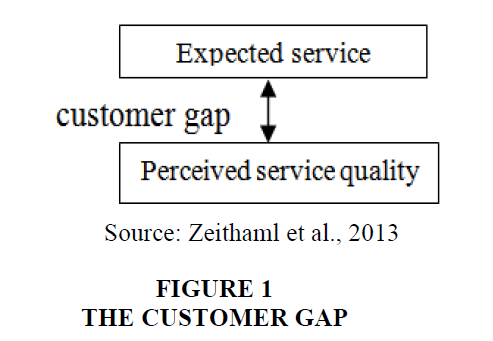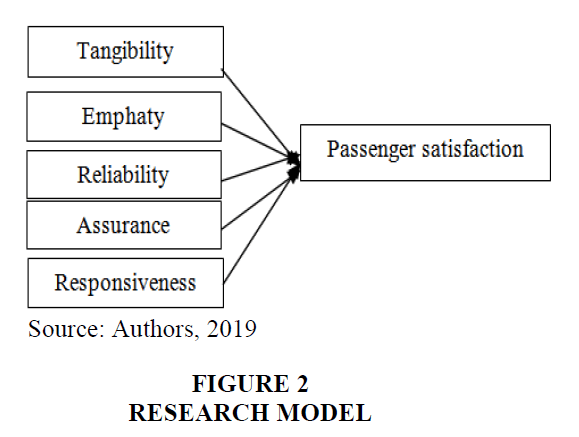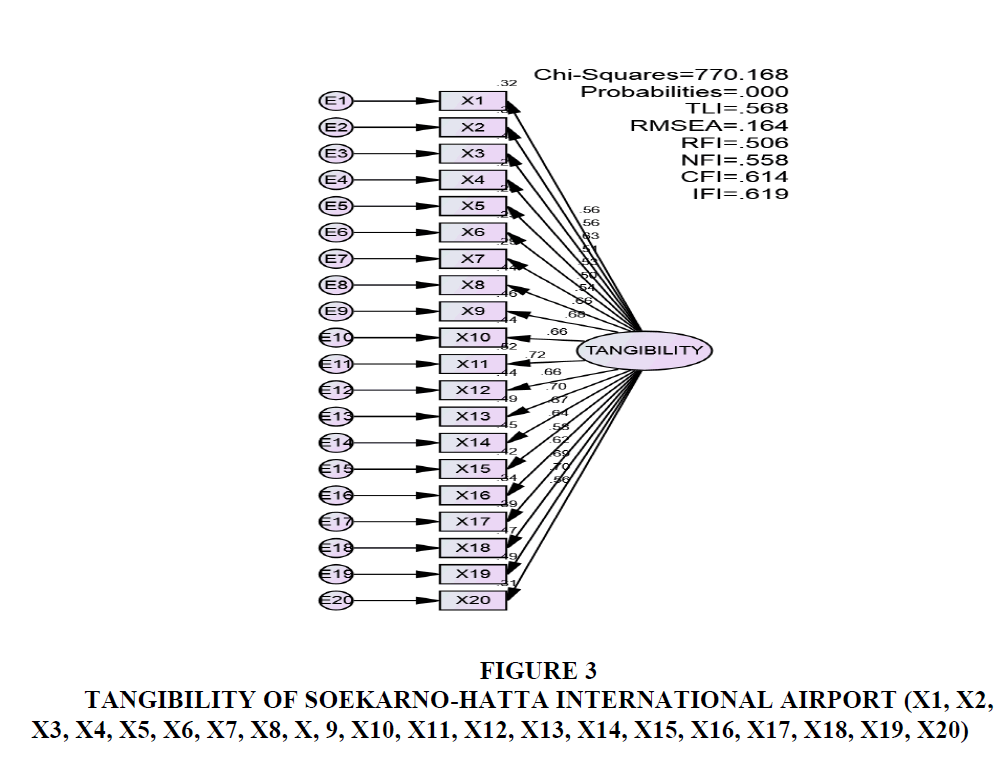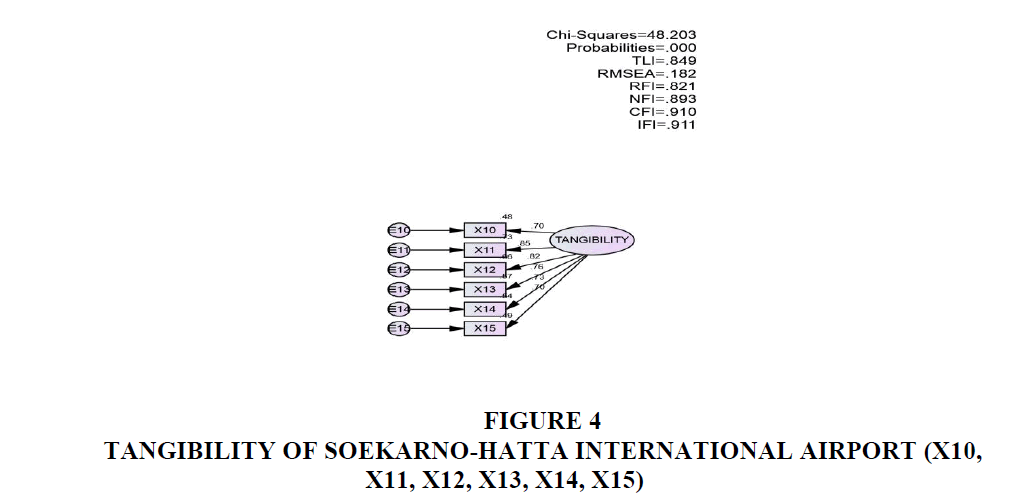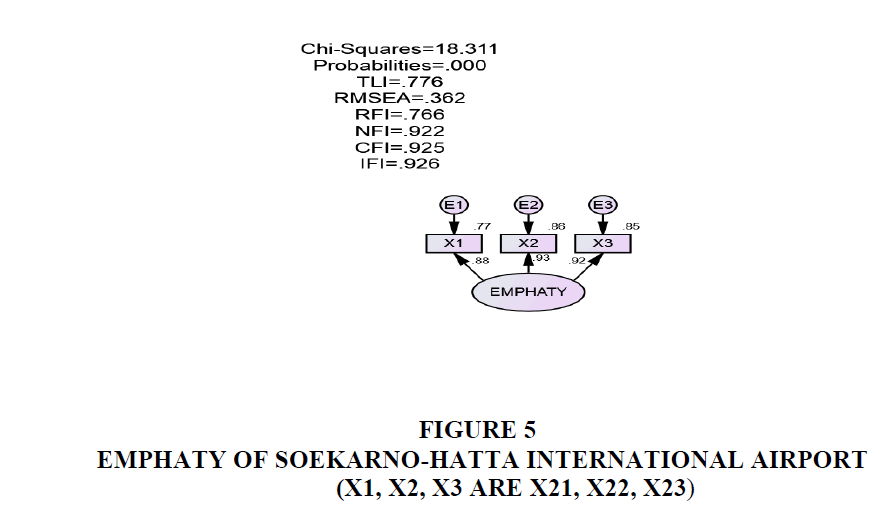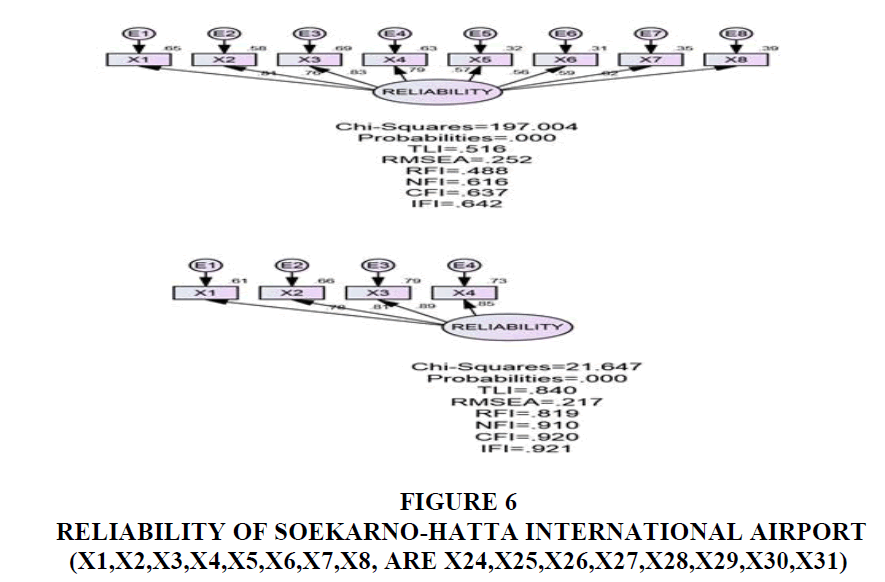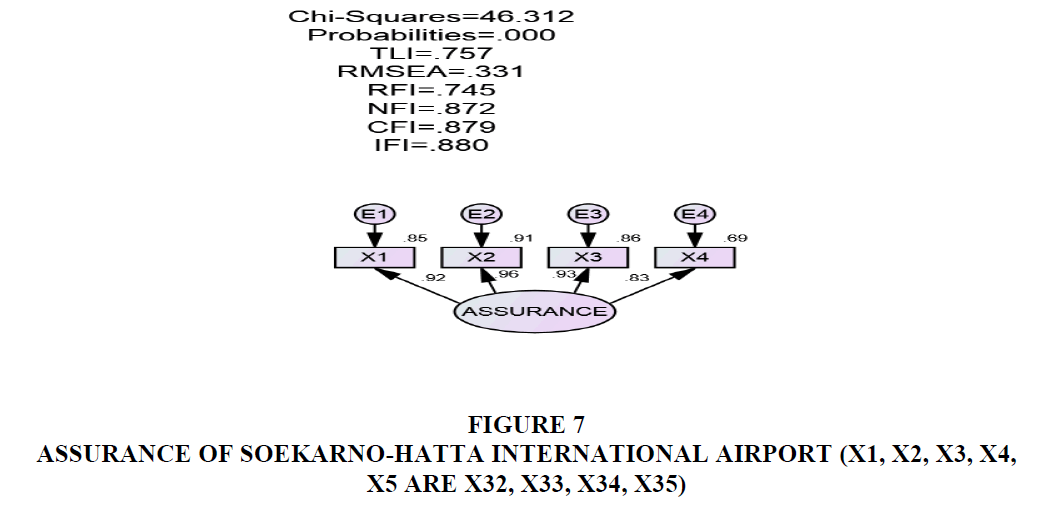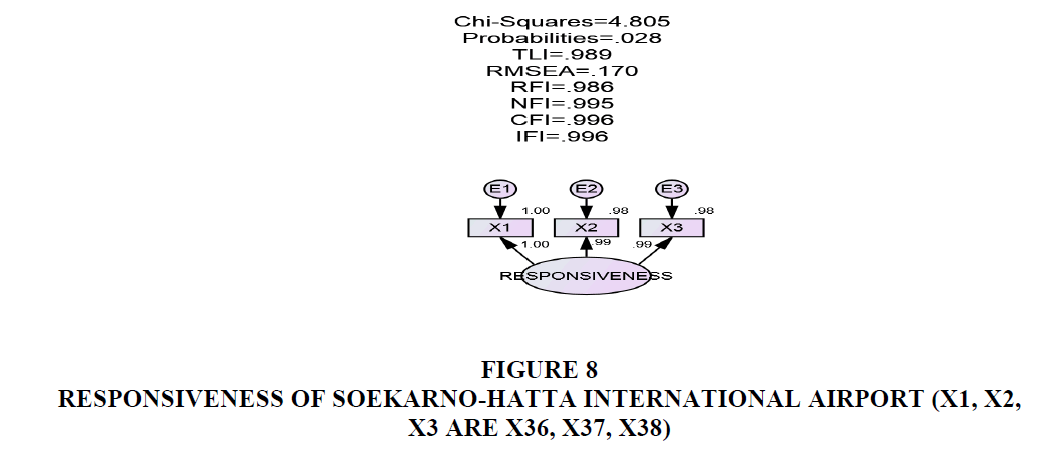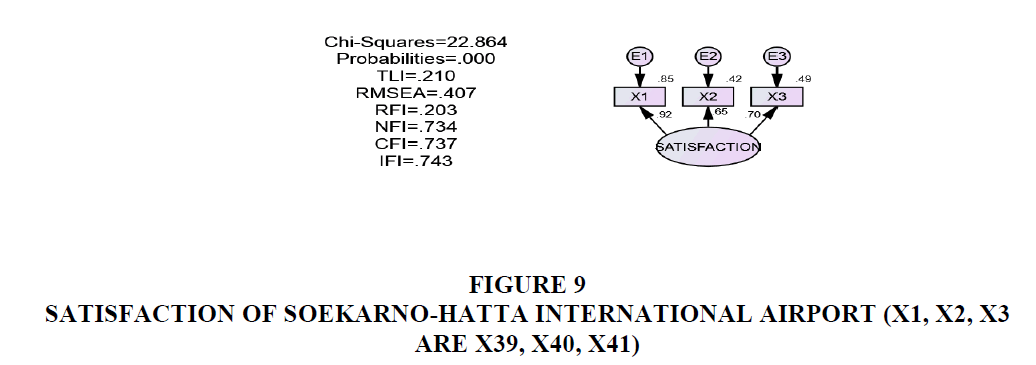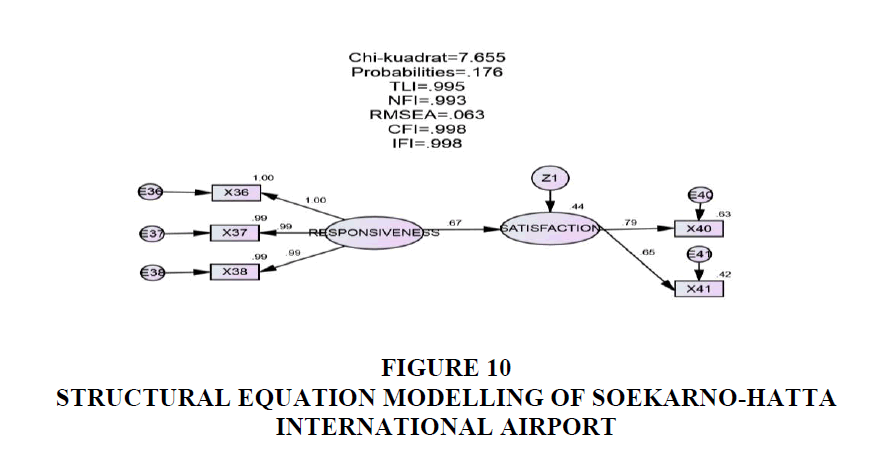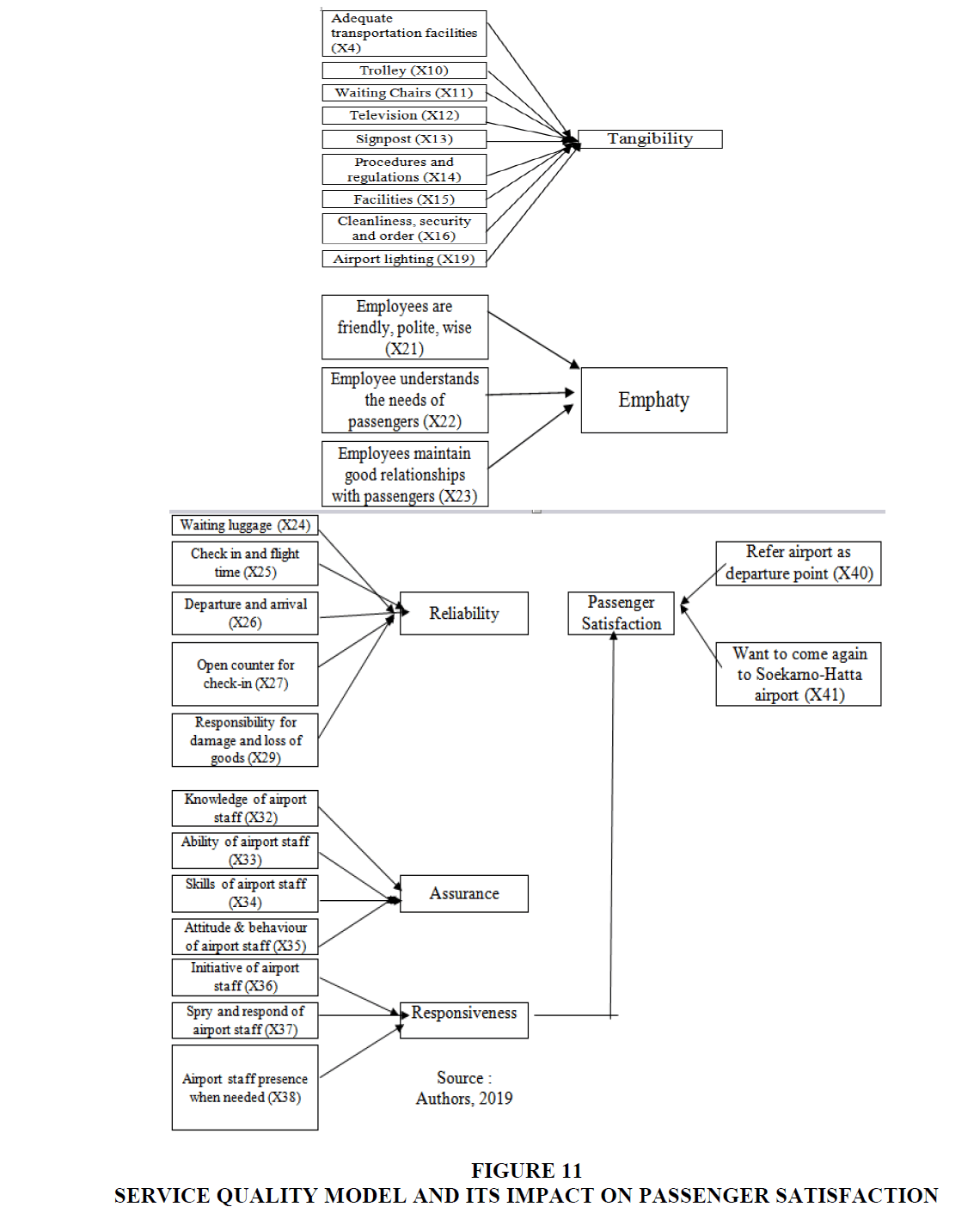Research Article: 2019 Vol: 23 Issue: 4
A Model of Service Quality to Improve International Airports Ranking Stars
Ida Nuraida, Parahyangan Catholic University
Lilian Danil, Parahyangan Catholic University
Abstract
Satisfaction of the passengers is an important part of the service provided at the airport. An independent agency called Skytrax conducted a survey on passenger satisfaction from international airports all over the the world. The aim of this empirical research is to propose a model of service quality and passenger satisfaction for Soekarno-Hatta International Airport and other international airports in Indonesia to increase the airport ranking stars. This research uses the quantitative method. Quantitative research conducted by the AMOS confirmatory analysis, subsequently continued by Structural Equation Modelling, interviews and observations. Among all service quality, responsiveness is the most important thing in increasing passenger satisfaction at international airports.
Keywords
Airport, Passengers Satisfaction, Service Quality.
Introduction
The growth of the middle class in Indonesia has been very rapid over the last five years to reach 56.5%, thus increasing the need for more convenient and quick transportation for both business and leisure. One of them is a change in the selection of a rapid means of transportation, namely by using air transportation. It is also supported by the ease of making ticket purchasing transactions and competitive rates between airlines, and the ease of completing check-in process, by using an online system. In traveling by air transport ie aircraft cannot be separated from the airport used for landing and takeoff for the aircraft. According to the transportation department, the airport is an area on land and / or water with certain limits used as a place for landing and take-off aircraft, passengers, loading and unloading of goods, and places of intra- and intermodal transport, equipped with facilities flight safety and security, as well as basic facilities and other supporting facilities. One of the airports in Indonesia is the Soekarno-Hatta international airport (Cengkareng) located in Jakarta as the capital of the Republic of Indonesia, which is one of the centers for domestic and international flights.
The airport is a company engaged in services, so customer satisfaction is very important. Research on customer satisfaction has been conducted by Skytrax. Skytrax is a company that researches the services provided by airlines and airports, and ranks the results of its research. One of Skytrax's assessments is Soekarno-Hatta International Airport, which is located around Jakarta as the capital city of the Republic of Indonesia. Because of its location in the capital city of Indonesia, this airport can become an example for other international airports in Indonesia.The results from Skytrax assess the International Airport Soekarno-Hatta Jakarta as an airport that is still not included in the top 10 world airports that provide the best service. The world’s top ten airports which have 5-stars airport ranking are 1) Singapore Changi Airport, 2) Incheon International Airport, 3)Tokyo Haneda International Airport, 4) Hong Kong International Airport, 5) Hamad International Airport, 6) Munich Airport, 7) Chubu Centrair International Airport, 8) London Heathrow Airport, 9) Zurich Airport, 10) Frankfurt Airport. Soekarno-Hatta International Airport has 3-stars.
To find out the perception of passengers on the quality of service in Soekarno-Hatta, preliminary research has been conducted involving 30 respondents aged over 20 years, who had visited the airport Soekarno Hatta. The overall results for each element can be seen in Table 1.
| Table 1: Preliminary Research | |||
| JKT | SING | HK | |
|---|---|---|---|
| Tangibility | 3.51 | 4.24 | 4.06 |
| Empathy | 3.46 | 3.63 | 3.53 |
| Reliability | 3.25 | 4.01 | 3.90 |
| Assurance | 3.56 | 4.13 | 3.94 |
| Responsiveness | 3.17 | 4.07 | 3.90 |
Source: Authors, 2019
From the preliminary survey results, Soekarno Hatta airport is still lagging behind Changi International Airport and Hongkong International Airport. Especially in terms of responsiveness and reliability due to the luggage waiting time for Soekarno Hatta airport, it is considered to be still poor (2.8). Factors supporting the tangibility of Soekarno Hatta airport are still below 2 other airports, especially hygiene (2.83) and lighting (2.83).
In order to increase the airport ranking star, this article tries to find out: 1) what factors affect every service quality at Soekarno-Hatta international airport; 2) which service quality increase passenger satisfaction at Soekarno-Hatta international airport. The results of this empirical study are to create a model of service quality, as well as determining which service quality can increase passenger satisfaction at Soekarno-Hatta International Airport and also increase the airport ranking stars. This study uses the quantitative method by analyzing the answers of 133 questionnaires from respondents, with AMOS confirmation analysis, proceeding with Structural Equation Modeling (SEM). This model is complemented by interviews and observations.
Literature Review
Airports are places where passengers wait for departure to a place and arrival to the destination in a relatively short amount of time compared to using land and sea transportation. The airport industry is described by the Airport Council International, an airborne airport association of the United States by Rhoades et al. (2000) covering eight components affecting airports, airlines, airport tenants, airport service, airport administration, airport, passenger, cargo and general aviation. Their description dividing into four factors related to the main services expected by passengers.
1. First factor: food and beverages, rest-room facilities, retail and duty free, and special services.
2. Second factor: airport access parking, rental car services, and ground transportation.
3. Third factor: areas of airline-airport interface: gate boarding areas, baggage claim facilities, and information displays.
4. Fourth factor: inter-terminal transportation.
Adisasmita (2012) states that it is important to know the condition of Soekarno-Hatta Airport, Indonesia, such as the suitability of space availability and passenger perceptions and performance at airport terminal facilities. Improved economic conditions followed by the increasing number of airlines in Indonesia effect to the price of air travel, which has became more affordable to the public. He analyzed this from the engineering and technological standpoint, measuring the passenger’s perception toward the performance, service level and prospect of terminal facilities development at the airport’s terminal building. The results of the Importance-Performance Analysis is as follows: the waiting room and food and beverages were prioritized for expansion; airline counters frontage/check-in, lobby and inspection (lobby and ticketing), and departure lounge were in good condition but must be maintained; baggage claim and baggage inspection areas indicated a certain impact on the satisfaction of service users; and airlines ticketing office, supporting services, and concourse did not affect the interest/satisfaction of service users.
As a service company, an airport should pay attention to service quality. Therefore, we need to understand which passenger perceptions of airport service quality can improve passenger satisfaction. According to Shahin (2006), service quality referes to the extent to which a service meets customers’ needs or expectations. If the expectations exceed the actual performance, then the perceived quality is less than satisfactory and hence customer dissatisfaction occurs (Shahin, 2006). In figure 1 the customer gap is the difference between customer expectations and perceptions (Zeithaml et al., 2013).
If the consumer's perception of service quality equals expectations, the consumer will be satisfied. If the consumer's perception of service quality is greater than expectations, then the consumer will be highly satisfied. If the consumer's perception of service quality is less than expected, the consumer will be dissatisfied. Satisfaction is obtained from the services provided by the airport; if there is a gap it means there is dissatisfaction from the customer.
With the growing interest in the subject, Airport Service Quality (ASQ) surveys have been systematically carried out by international agencies, regulatory authorities, airport operators, and other organizations (ACI, 2014; Fodness & Murray, 2007; IATA, 2015; Kramer et al., 2013; Zidarova & Zografos, 2011). In spite of systematic practices within the airport industry (ACI, 2014; IATA, 2015; Kramer et al., 2013; Zidarova & Zografos, 2011), usually, they have been more concerned with context-specific purposes and considerations regarding the reliability and validity aspects of the measurement instrument have received only limited attention (George et al., 2013). As airports are complex service settings, generic approaches for measuring service quality might not cover some specific characteristics related to the passenger-airport interaction (George et al., 2013, Pantouvakis, 2010). Non-aeronautical revenues have become critical for airport sustainability, which leads to increasing concerns with the marketing of retail areas within airport terminals (Gillen, 2011). Airport service quality would raise the level of transfer passengers’ satisfaction, value perceptions, and airport image formation. In addition, airport service quality has an indirect impact on transfer passenger behavior by means of value, satisfaction, and airport image (Park & Jung, 2011).
Bogicevic et al. (2013) developed Herzberg's two-factor motivation theory to explore most frequently mentioned attributes of airport service quality and distinguish key drivers for passenger satisfaction/dissatisfaction in the airport context. They analysed 1,095 traveler comments posted between 2010 and 2013 on an airport review web site which was performed in order to identify satisfying/dissatisfying factor. The web spider randomly selected consumer comments related to 33 popular destinations. The study results indicated key satisfiers in the airport context such as cleanliness and pleasant environment to spend time in. On the other side, security-check, confusing signage and poor dining offer are recognized as major dissatisfiers in the airport setting.
Service quality improvement of the people mover system in the grand design of Soekarno Hatta International Airport (SHIA) expected to support increasing airport service quality management (Kurniawan et al., 2017). They utilized the Fodness & Murray theory regarding the accurate scale to measure SHIA service quality by using the servqual method and Kano Model approach. Airport management at SHIA should focus on the improved operating system of the people mover system related to the attributes of punctuality, free of charge, status information about the schedule, headway, and safety.
There are six structural factors that provide a meaningful multi-item measurement model for perceived ASQ at Guarulhos International Airport, in Brazil. Those are 1) check-in (courtesy and helpfulness of check-in staff, check-in process efficiency, wait-time at check-in), 2) security (feeling of being safe and secure, courtesy and helpfulness of security staff, thoroughness of security screening, wait-time at security checkpoints), 3) convenience (availability and quality of stores, availability of banks/ATM/exchange, availability and quality of food facilities), 4) ambience (cleanliness of airport facilities, thermal comfort, acoustic comfort) 5) basic facilities (cleanliness of washroom/toilets, availability of washroom/toilets, departure lounge comfortand), 4) mobility (walking distance inside terminal, wayfinding, flight information) (Bezerra & Gomes, 2016).
This study uses a five-dimensional approach to service quality. Service quality is a focused evaluation that reflects the customer’s perception of: reliability, assurance, responsiveness, empathy, and tangibles. Satisfaction, on the other hand, is more inclusive: it is influenced by perceptions of service quality, product quality, and price as well as situational factors and personal factors. Definitions of service quality dimension:
1. Reliability: ability to perform the promised service dependably and accurately
2. Responsiveness: willingness to help customers and provide prompt service
3. Assurance: knowledge and courtesy of employees and their ability to inspire trust and confidence
4. Empathy: caring, individualized attention the firm provides its customers.
5. Tangibles: appearance of physical facilities, equipment, personnel, and communication materials (Zeithaml et al., 2013).
The service quality model provided by the airport consists of tangibility such as clues that can be understood by customers as customers coming from different countries speaking different languages, airport layouts, including immigration sections. The layout or layout includes open office space and closed office space (Nuraida, 2014), and also tenants from airports such as food and beverage, rental car services or retail stores. Reliability is more about the accuracy of the process, the responsibility of the person, the time of departure and arrival, as well as the time to conduct a re-check and baggage delivery (baggage delivery). Empathy, assurance and responsiveness are more about the attitude and behavior of airport employees. The capability of airport employees in dealing with customers is very important, it takes a polite and friendly attitude, an interesting and thoughtful personality, and adequate knowledge associated with the airport (Nuraida et al., 2015).
In general, Soekarno-Hatta international airport has elements of service that are listed in the column elements in Table 2. This research tries to describe the indicator in the second column in the Table 2 below.
| Table 2: Element Of Service Quality And The Indicators | |
| Elements | Indikators |
|---|---|
| Tangibles | |
| Sign & Simbols | There are written procedures and regulations that are complete, clear, and easy to understand and adhered to. The clarity of the sign indicates a good direction. |
| Layout & Function | The distance between the check in and the adjacent gate. There is a toilet between check-in and gate. Comfort and convenience for passengers (sitting chairs, staircases, trolleys). |
| Airport Tenant | Available retail store between check-in and gate. There is an ATM between check-in and gate. Available money changer between check-in and gate. There is a restaurant between check-in and gate. There is a minimarket between check-in and gate. There are adequate means of transportation. There are internet and other IT facilities. |
| Airport environment | Clean airport. The security and order of the airport visitors is good. Airport air temperature is pleasant. The arrangement of colors (walls, floor chairs) at the airport is unsightly. The airport lighting is good. No noise from the airport. |
| Empathy | |
| Attitude & Behavior | Friendly employee attitude. The attitude of friendly employees. Employees understand the needs of passengers. Airport employees offer personal assistance. Serve with courtesy, friendly and thoughtful. |
| Reliability | |
| Timing reliability | Waiting time for fast delivery of luggage. The opening times of check-in and flight time are appropriate. Timeliness of departure and arrival (outside of special cases, such as weather factors). Punctuality of airport service personnel, such as open counters for check-in, airport tax, and others. |
| Quality of information and service | Provision of accurate information can be accounted for, including information on aircraft delay due to special cases. The airport officer's liability for damage to goods in baggage, loss of goods in the trunk, is good. Effective and efficient service procedures, including complaints. The overall service quality of the airport is good. |
| Assurance | |
| Attitude & Behavior | Airport staffs have the appropriate attitude and work attitude in serving the passengers. |
| Expertise | Airport staffs have knowledge of doing their job. Airport staffs are skilled in doing their work. Airport staffs have the ability to do their job. |
| Responsiveness | |
| Attitude & Behavior | The airport staff took the initiative to help passengers who encountered difficulties / problems. The airport staff is quick and responsive to respond to the needs of passengers. Airport members are on site when needed. |
Source : Authors, 2019
Research Methods
This research uses quantitative methods (AMOS Confirmation Analysis and Structural Equation Modeling), complemented by qualitative methods of interview and observation to complete the analysis.
“Quantitative research involves strategy of inquiry such as experimental and surveys, and collect data on predertemined instruments that yield statistical data” (Creswell, 2009).
Data collection techniques performed are the following.
1. Primary data through interviews direct observation and questionnaires in the Techniques Interviews: in this writing interview techniques are required to know, track and collect information about services provided by the airport. The interview was conducted to 50 respondents, consisting of 10 people from tour travel, and 40 people who often use the airport at least 3 times.
2. Questionnaires were distributed to 300 respondents who had visited the airports, but only 133 responded.
3. If we develop a model with 20 parameters, then the minimum sample should be used are as many as 100 samples. (Ferdinand, 2014).
4. This means that the number of respondents must be collected at least 5 times the number of indicators most in each construct. Questions in the questionnaire consisted of 5 constructs (Tangibility, Emphaty, Reliability, Assurance and Responsiveness). The highest indicator is in Reliability of 8 indicators. Thus the sample of respondents expected to enter is amounted to 5 times 8 indicators that is as many as 40 samples. In addition, questions were also asked about the level of satisfaction of respondents who have visited the airport. Questions in the questionnaire used the Likert scale 1-5, providing closed questions to the respondents. Data were processed with the SPSS program and the AMOS confirmatory factor analysis for the validity and reliability test. The influence of the construct whose model is fit views its effect on satisfaction by using Structural Equation Modeling.
5. Secondary data from the PT Angkasa Pura website, literature study and previous written results.
Research Model
The research model is as follows.
Service quality consist of tangibility, empathy, reliability, assurance, and responsiveness, which affect the satisfaction of passengers at Soekarno-Hatta international airport in figure 2.
Variable Operationalization
Operationalization of variables consists of the following.
Based on Table 3 above, this article tries to develop indicators that can influence each construct of service quality. The TERAR construct cannot be directly measured/cannot be directly observed, so it needs to be manifested/measured/observed with indicators embodied in the form of questions with a Likert scale of 1-5. So the hypotheses are as follows.
| Table 3: Constructs And Indicators Of Service Quality | |
| TANGIBILITY: airport physical facilities. | |
| MAIN FACILITIES | |
| X1 X2 X3 X4 |
The distance between the check-in and the adjacent gate. Toilet between check-in and gate. Escalator. Adequate transportation facilities. |
| SUPPORTING FACILITIES | |
| X5 X6 X7 X8 X9 |
Retail store between check-in and gate. ATM between check-in and gate. Money changer between check-in and gate. Restoran between check-in and gate. Minimarket between check-in and gate. |
| INFRASTRUCTURE | |
| X10 X11 X12 X13 X14 X15 |
Trolleys. Waiting chair. Television. The signpost is clear. The procedures and regulations are complete, clear, and easy to understand. Internet and IT facilities. |
| X16 | Maintain cleanliness, security and order. |
| AIRPORT ENVIRONMENT | |
| X17 X18 X19 X20 |
Airport air temperature is pleasant. Airport color arrangement is good. The airport lighting is good. No airport noise. |
| EMPHATY: ability to understand / pay attention to consumers. | |
| X21 X22 X23 |
Employees are friendly, polite, thoughtful and friendly. Employees understand the needs of passengers by offering personal Assistance. Employees build good relationships with passengers |
| RELIABILITY:provide service and services promised accurately and accountable | |
| X24 X25 X26 X27 |
Waiting for fast luggage Check in and flight times accordingly Departures and arrivals (excluding special cases, such as weather factors) Open counter for check-in, airport tax, etc. |
| X28 X29 X30 X31 |
Provision of accurate information, can be justified Responsibility for goods damage, loss of goods Effective-efficient procedures, including complaints The overall service is good |
| ASSURANCE:knowledge, skills, abilities, attitudes, good manners shown by airport officials, airline pilots and flight attendants provide assurance that anyone who buys services at the airport will be handled by the right people (keeping consumer confidence). | |
| X32 X33 X34 X35 |
The knowledge of the airport staff is good The capability of the airport staff is good The skill of the airport staff is good The attitude and behavior of the airport staff is good |
| RESPONSIVENESS: desire and speed help proportionally in providing the right services and services. | |
| X36 X37 X38 |
Airport staff took the initiative to help passengers who are confused, or face problems The airport staff is quick and responsive to passenger needs Airport staff are on site when needed |
| SATISFACTION: the perception of service quality is equal to or greater than expected. | |
| X39 X40 X41 |
Election of airport as departure airport to go abroad Refer the airport as a departure airport to colleagues Want to come again to Soekarno-Hatta airport |
Source: Authors, 2019
H1: Tangibility is determined by the distance check-in and gate, toilet, staircase, transportation, retail store, ATM, money changer, restaurant, mini market, trolley, waiting chair, TV, directions, procedures, IT facilities, air temperature, color, lighting, sound.
H2: Emphaty is determined by friendly employees-good manners-wisdom, understanding passenger needs, fostering good relationships with passengers.
H3: Reliability is determined by time of luggage waiting, check-in and flight times, departure and arrival, open counter for check in, accurate information, responsibility for goods, effective and efficient procedures, overall service.
H4: Assurance is determined by the knowledge, skills, behaviour, attitude of the airport staff.
H5: Responsiveness is determined by the airport staff who take the initiative, being sprightly responsive response to the needs of passengers, and they are there when needed.
H6: Satisfaction is determined by the selection of the airport as a departure airport, referring to the nearest person or colleagues, wanting to come to the airport with them.
H7: Satisfaction is determined by tangibility, empathy, reliability, assurance and responsiveness.
The indicators in each construct namely tangibility, empathy, reliability, assurance, and responsiveness, will be tested to determine which of them becomes part of each construct. So that it can be known which hypothesis will be accepted and which will be rejected. Then we will find out which passenger perceptions of airport service quality can improve passenger satisfaction.
Results
This research collects primary data through questionnaires, interviews and direct observation.
Questionnaire Results
The questionnaires were obtained from 133 respondents. All 133 respondents are Indonesian citizens.
Confirmatory analysis of tangibility, emphaty, reliability, assurance and responsiveness
In conducting a confirmatory analysis is this research used a minimum of 0.6 factor loading (Sharma, 1996). There are 5 constructs to be tested (tangibility, emphaty, reliability, assurance and responsiveness) of each airport, with a total of 38 indicators (X1-X38). In the tangibility category there are 20 indicators (X1-X20), for emphaty there are 3 indicators (X21-X23), for reliability there are 8 indicators, for assurance there are 4 indicators, and for responsiveness there are 3 indicators. Confirmatory analysis is performed several times until all indicators have a loading factor of ≥0.6. Each indicator starts from X1.
To see suitability of the model, the author uses 8 indexes taken from Ferdinand (2014), as follows in Table 4.
| Table 4 : Goodness-Of-Fit Indices | ||
| No | Goodness of fit index | Cut-off value |
|---|---|---|
| 1 | Chi-Square | Expected low |
| 2 | Probabilities | ≥ 0.01 |
| 3 | TLI (Tucker Lewis Index) | ≥ 0.95 |
| 4 | RMSEA (Root Mean Square Error of Approximation) | ≤ 0.08 |
| 5 | RFI (Relative Fit Index) | ≥ 0.95 |
| 6 | NFI (Normed Fit Index) | ≥ 0.95 |
| 7 | CFI (Comparative Fit Index) | ≥ 0.95 |
| 8 | IFI (Incremental Fit Index) | Mendekati 1 |
The results of confirmatory analysis of each tangibility construct, empathy, reliability, assurance and responsiveness of Soekarno-Hatta International Airport will be explained as follows.
From the figure 3 & figure 4 above, there are 14 indicators that are discarded. This is also indicated by standardized regression weights below in Table 5.
| Table 5:Standardized Regression Weights: (Group Number 1-Default Model) | |||
| Estimate | |||
|---|---|---|---|
| X15 | <--- | TANGIBILITY | 0.700 |
| X14 | <--- | TANGIBILITY | 0.732 |
| X13 | <--- | TANGIBILITY | 0.758 |
| X12 | <--- | TANGIBILITY | 0.815 |
| X11 | <--- | TANGIBILITY | 0.852 |
| X10 | <--- | TANGIBILITY | 0.696 |
Figure 3:Tangibility Of Soekarno-Hatta International Airport (X1, X2, X3, X4, X5, X6, X7, X8, X, 9, X10, X11, X12, X13, X14, X15, X16, X17, X18, X19, X20)
With a loading factor of more than 0.6, the indicators X10, X11, X12, X13, X14 and X15 really explain / reflect / manifest / measure the construct of tangibility of Soekarno-Hatta in Table 6.
| Table 6:Variances (Group Number 1-Default Model) | |||||
|---|---|---|---|---|---|
| Estimate | S.E. | C.R. | P | Label | |
| TANGIBILITY | 1.000 | ||||
| E15 | 0.506 | 0.071 | 7.134 | *** | par_13 |
| E14 | 0.304 | 0.044 | 6.836 | *** | par_14 |
| E13 | 0.228 | 0.034 | 6.722 | *** | par_15 |
| E12 | 0.188 | 0.031 | 6.055 | *** | par_16 |
| E11 | 0.176 | 0.032 | 5.436 | *** | par_17 |
| E10 | 0.247 | 0.035 | 7.130 | *** | par_18 |
The error here shows reliability (consistency, stability) as indicated by the amount of error. Because the error indicators X10, X11, X12, X13, X14 to X15 are significant, it shows a small error so that it can be said to be stable / consistent.
From the figure 5 above, there are no discarded indicators. This is also indicated by standardized regression weights below in Table 7.
| Table 7: Standardized Regression Weights: (Group Number 1-Default Model) (X1, X2, X3 Are X21, X22, X23) | |||
| Estimate | |||
|---|---|---|---|
| X1 | <--- | EMPHATY | 0.878 |
| X2 | <--- | EMPHATY | 0.926 |
| X3 | <--- | EMPHATY | 0.923 |
With a loading factor of more than 0.6, the X21, X22 and X23 indicators really explain / reflect / manifest / measure the Soekarno-Hatta emphaty construct in Table 8.
| Table 8: Variances: (Group Number 1-Default Model) (E1, E2, E3 Are E21, E22, E23) | |||||
| Estimate | S.E. | C.R. | P | Label | |
|---|---|---|---|---|---|
| EMPHATY | 1.000 | ||||
| E1 | 0.298 | 0.048 | 6.232 | *** | par_6 |
| E2 | 0.181 | 0.041 | 4.366 | *** | par_7 |
| E3 | 0.158 | 0.035 | 4.527 | *** | par_8 |
The error here shows reliability (consistency, stability) as indicated by the amount of error. Because X11, X12 and X13 indicator errors are significant, it shows a small error so that it can be said to be stable / consistent.
From the figure 6 above, there are 4 indicators that are discarded. This is also indicated by standardized regression weights below in Table 9.
| Table 9: Standardized regression weights: (group number 1-default model) (X1,X2,X3,X4,X5,X6,X7,X8 ARE X24,X25,X26,X27,X28,X29,X30,X31) | |||
| Estimate | |||
|---|---|---|---|
| X1 | <--- | RELIABILITY | 0.783 |
| X2 | <--- | RELIABILITY | 0.810 |
| X3 | <--- | RELIABILITY | 0.892 |
| X4 | <--- | RELIABILITY | 0.852 |
Figure 6: Reliability Of Soekarno-Hatta International Airport (X1,X2,X3,X4,X5,X6,X7,X8, Are X24,X25,X26,X27,X28,X29,X30,X31).
With a loading factor of more than 0.6, the X24, X25, X26 and X27 indicators really explain / reflect / manifest / measure the construct of Soekarno-Hatta reliability in Table 10.
| Table 10: Variances: (Group Number 1-Default Model) (E1,E2,E3,E4,E5,E6,E7,E8 Are E24,E25,E26,E27,E28,E29,E30,E31) | |||||
| Estimate | S.E. | C.R. | P | Label | |
|---|---|---|---|---|---|
| RELIABILITY | 1.000 | ||||
| E1 | 0.631 | 0.092 | 6.843 | *** | par_8 |
| E2 | 0.316 | 0.050 | 6.347 | *** | par_9 |
| E3 | 0.173 | 0.039 | 4.477 | *** | par_10 |
| E4 | 0.208 | 0.038 | 5.495 | *** | par_11 |
The error here shows reliability (consistency, stability) as indicated by the amount of error. Because the X24, X25, X26 and X27 error indicators are significant, it shows a small error so that it can be said to be stable / consistent.
From the figure 7 above, no indicator is discarded. This is also indicated by standardized regression weights below in Table 11.
| Table 11: Standardized Regression Weights: (Group Number 1-Default Model) (X1, X2, X3, X4, X5 ARE X32, X33, X34, X35) | |||
| Estimate | |||
|---|---|---|---|
| X1 | <--- | ASSURANCE | 0.922 |
| X2 | <--- | ASSURANCE | 0.956 |
| X3 | <--- | ASSURANCE | 0.929 |
| X4 | <--- | ASSURANCE | 0.832 |
Figure 7: Assurance Of Soekarno-Hatta International Airport (X1, X2, X3, X4, X5 Are X32, X33, X34, X35).
With a loading factor of more than 0.6, the indicators X32, X33, X34, and X35 really explain / reflect / manifest / measure the assurance construct of Soekarno-Hatta in Table 12.
| Table 12 : Variances: (Group Number 1-Default Model) (E1, E2, E3, E4, E5 ARE E32, E33, E34, E35) | |||||
| Estimate | S.E. | C.R. | P | Label | |
|---|---|---|---|---|---|
| ASSURANCE | 1.000 | ||||
| E1 | 0.177 | 0.029 | 6.144 | *** | par_8 |
| E2 | 0.075 | 0.018 | 4.101 | *** | par_9 |
| E3 | 0.115 | 0.021 | 5.437 | *** | par_10 |
| E4 | 0.276 | 0.038 | 7.242 | *** | par_11 |
The error here shows reliability (consistency, stability) as indicated by the amount of error. Because X32, X33, X34, and X35 indicator errors are significant, it shows a small error so that it can be said to be stable / consistent.
From the figure 8 above, no indicator is discarded. This is also indicated by standardized regression weights below in Table 13.
| Table 13: Standardized Regression Weights: (Group Number 1 - Default Model) (X1, X2, X3 ARE X36, X37, X38) | |||
| Estimate | |||
|---|---|---|---|
| X1 | <--- | RESPONSIVENESS | 1.000 |
| X2 | <--- | RESPONSIVENESS | 0.992 |
| X3 | <--- | RESPONSIVENESS | 0.992 |
With a loading factor of more than 0.6, the indicators X36, X37, and X38 really explain / reflect / manifest / measure the construct of the Soekarno-Hatta responsiveness in Table 14.
| Table 14: Variances: (Group Number 1 - Default Model) (E1, E2, E3 Are E36, E37, E38) |
|||||
| Estimate | S.E. | C.R. | P | Label | |
|---|---|---|---|---|---|
| RESPONSIVENESS | 1.000 | ||||
| E1 | 0.000 | 0.001 | -0.079 | 0.937 | par_6 |
| E2 | 0.015 | 0.002 | 6.640 | *** | par_7 |
| E3 | 0.015 | 0.002 | 6.640 | *** | par_8 |
The error here shows reliability (consistency, stability) as indicated by the amount of error. Error X36 indicator is not significant because 0.937> α 10%. X37 and X38 indicator errors are significant, so it shows a small error so that it can be said to be stable / consistent.
From the figure 9 above, no indicator is discarded. This is also indicated by standardized regression weights below in Table 15.
| Table 15: Standardized Regression Weights: (Group Number 1 - Default Model) (x1, x2, x3 are x39, x40, x41) | |||
| Estimate | |||
|---|---|---|---|
| X1 | <--- | SATISFACTION | 0.922 |
| X2 | <--- | SATISFACTION | 0.651 |
| X3 | <--- | SATISFACTION | 0.699 |
With a loading factor of more than 0.6, the indicators X39, X40, and X41 really explain / reflect / manifest / measure the construct of the Soekarno-Hatta responsiveness in Table 16.
| Table 16: Variances: (Group Number 1 - Default Model) (E1, E2, E3 ARE E39, E40, E41) | |||||
| Estimate | S.E. | C.R. | P | Label | |
|---|---|---|---|---|---|
| SATISFACTION | 1.000 | ||||
| E1 | 0.175 | 0.184 | 0.952 | 0.341 | par_6 |
| E2 | 0.438 | 0.101 | 4.324 | *** | par_7 |
| E3 | 0.346 | 0.093 | 3.707 | *** | par_8 |
The error here shows reliability (consistency, stability) as indicated by the amount of error. The X39 indicator error is not significant because 0.341> α 10%. X40 and X41 indicator errors are significant, so it shows a small error so that it can be said to be stable / consistent.
Based on AMOS confirmatory analysis results, all hypotheses 1 to hypothesis 6 are accepted because each construct has an indicator with a loading factor of ≥0.6. The summary of the confirmatory results of each construct of tangibility, emphaty, reliability, assurance and responsiveness of the airport and its indicators are as follows in Table 17.
| Table 17 : Final Result Of Confirmation Analysis Terar For Soekarno-Hatta International Airport | |||
| Analysis of constructs | Indicator of the construct discarded due to loading factor <0.6 | Indicator of the construct received due to loading factor ≥ 0.6 | Compared with cut-off value (fit model) and reliability test |
|---|---|---|---|
| Tangibility (hypothesis 1) | 11 discarded : X1= Short distance between the check-in and the adjacent gate X2= The toilet between check-in and gate X3= Escalator X5= The retail store between check-in and gate X6= ATM between check in and gate X7= Money changer between check-in and gate X8= Restaurant between check-in and gate X9= Minimarket between check-in and gate X17= Airport air temperature is pleasant X18= Airport color arrangement is good X20= No airport noise |
X4 = Adequate transportation facilities X10 = Trolley X11 = Waiting Chairs X12 = Television X13 = The signposts are clear X14 = The procedures and regulations are complete, clear, and easy to understand X15 = Internet and IT facilities X16 = Maintain cleanliness, security and order X19 = The airport lighting is good |
Only IFI is close to 1 (0.911) |
| Emphaty (hypothesis 2) | None | X21 = Airport staff are friendly, polite, wise, friendly X22 = Airport staff understands the needs of passengers by offering personal assistance X23 = Airport staff maintain good relationships with passengers |
Only IFI is close to 1 (0.926) |
| Reliability (hypothesis 3) | 3 discarded : X28 = Provision of accurate, reliable information X30 = Effective-efficient procedure, including complaints X31 = Good overall service |
X24 = Waiting for quick luggage X25 = Check in and flight time accordingly X26 = Departure and arrival (excluding special cases, such as weather factors) X27 = Open counter for check-in, airport tax, etc. X29 = Responsibility for damage and loss of goods |
Only IFI is close to 1 (0.921) |
| Assurance (hypothesis 4) | None | X32 = Knowledge of airport staff is good X33 = Good airport staff capability X34 = Good airport staff skills X35 = The attitude and behavior of airport staff are good |
Nothing is fit with cut-off value |
| Responsiveness (hypothesis 5) | None | X36 = Airport staff took the initiative to help passengers who are confused, or face problems X37 = Spry and fast airport staff responsive to passenger needs X38 = Airport staff presence when needed |
Fit cut-off value : probabilities, TLI,RFI,NFI,CFI,IFI |
| Satisfaction (hypothesis 6) | None | X39 = Selection of airport as departure airport to go abroad X40 = Refer the airport as a departure airport to colleagues X41 = Coming back to Soekarno-Hatta airport |
There is no corresponding cut-off value. X39 is not reliable (error 0.341> α 10% so it is discarded. |
Source: Authors, 2019
Of the 8 indices used, the index approaching the fit model for the TERAR airport independent variable Soekarno-Hatta is responsiveness. Hence hypothesis 7 is accepted with the adjustment that is only responsivenss that affect the satisfaction, whereas tangibility, empathy, reliability and assurance can not be seen as influential on satisfaction because it does not meet the cut off value.
Structural Equation Modelling
Satisfaction = 0.667 responsiveness + Z1. From the figure 10, Table 18 and Table 19 above can be known from the column probability responsiveness that there is a positive relationship with satisfaction. Signification means there is consistency with the probability of obtaining a critical ratio as large as 5.042 in absolute value is less than 0.001. If respondents rate high on responsiveness, it will also consistently rate high on satisfaction, and vice versa. From Table 7 it can be seen from estimate responsiveness column to satisfaction is 0,895. This means that if responsiveness rose 10%, it will result in increased satisfaction of 10% x 0.895 = 8.95%.
| Table 18: Squared Multiple Correlations: (Group Number 1 - Default Model) | |
| Estimate | |
|---|---|
| SATISFACTION | 0.445 |
| X41 | 0.424 |
| X40 | 0.629 |
| X36 | 1.000 |
| X37 | 0.985 |
| X38 | 0.985 |
| Table 19: Regression Weights: (Group Number 1 - Default Model) | |||||||
| Estimate | S.E. | C.R. | P | Label | |||
|---|---|---|---|---|---|---|---|
| SATISFACTION | <--- | RESPONSIVENESS | 0.895 | 0.177 | 5.042 | *** | par_3 |
| X38 | <--- | RESPONSIVENESS | 1.000 | ||||
| X37 | <--- | RESPONSIVENESS | 0.995 | 0.017 | 57.903 | *** | par_1 |
| X36 | <--- | RESPONSIVENESS | 1.005 | 0.012 | 81.933 | *** | par_2 |
| X40 | <--- | SATISFACTION | 0.493 | 0.080 | 6.145 | *** | par_4 |
| X41 | <--- | SATISFACTION | 0.372 | 0.061 | 6.145 | *** | par_5 |
Interviews and Observations
The interview was conducted with 50 people who have used the services of Soekarno-Hatta international airport. Direct observation was made by the author at the location of the airport. Based on the results of the interview, passengers considered the poor service quality as follows.
1. Tangibility: the safety factor of passenger goods is felt to be less than satisfying, be it loss or damage. Cleanliness is poorly cared for. The lack of the order factor is caused by the arbritary behavior of Indonesian people and the airport is less assertive in ordering and controlling it. This certainly requires the procedures, regulations and addition of airport employees.
2. Responsiveness is less than satisfyng when employees are not in place when needed.
Based on observations of the airport, the bad aspects are tangibility either in terms of cleanliness, neatness, completeness or misuse of facilities. Responsiveness of airport personnel is below standard, which is captured by cameras in the absence of employees at work during office hours.
Discussion
As mentioned earlier, the main purpose of this paper is to find out the model of service quality and its effect on passenger satisfaction. The model is illustrated in Figure 8 above. Based on the AMOS confirmatory analysis and Structural Equation Modeling, valid indicators are found to influence each construct of tangibility, emphaty, reliability, assurance, responsiveness and satisfaction because it has a loading factor> 0.6, and each indicator is reliable because it has an error <α 10 %. Based on the results above, the service quality model and its impact on passenger satisfaction are as follows in figure 11.
In Table 20 below, the valid indicators of each construct of service quality in the model are accompanied by explanations from interviews with 50 passengers on best and worst impressions of airports, complimented by field observations.
| Table 20: Explanation Of Service Quality Model And Its Impact On Passenger Satisfaction | ||
| Construct | Indicators (loading factor > 0,6 and error < 10%) | Explanation (from interviews and observations) |
|---|---|---|
| Tangibility | X4 = Adequate transportation facilities | Bus, train. |
| X10 = Trolleys | Adequate, available in place, in good working order. | |
| X11 = Waiting chair | Adequate, in good condition. | |
| X12 = Television | Operating well. | |
| X13 = The signposts are clear | Arrows, airport lay out, airport map. | |
| X14 = The procedures and regulations are complete, clear, and easy to understand | It does not take too long to be understood and implemented. | |
| X15 = Internet and IT facilities | Adequate, available and operating well as needed. | |
| X16 = Maintain cleanliness, security and order | Cleanliness: the dump is quite adequate, the bathroom is clean and not smelly, the outside of the bathroom area does not smell, the visitors and passengers throw the garbage in its place, not spitting haphazardly Order: visitors and tenant employees do not abuse the use of airport facilities, as seats are used as they should, do not use a few chairs to sleep so that other passengers can sit down. Security of goods in the cabin and luggage: laptops, luggage, expensive goods, etc. |
|
| X19 = The airport lighting is good | Adequate | |
| Emphaty | X21 = Airport staff are friendly, polite, wise, friendly | Good manners, polite behavior, patient, smiling face. |
| X22 = Airport staff understands the needs of passengers by offering personal assistance | For passengers who need information, find difficulties, help find solutions. | |
| X23 = Airport staff maintain good relationships with passengers | Good communication, passengers feel comfortable served. | |
| Reliability | X24 = Waiting for quick luggage | Goods can be immediately taken by the owner. |
| X25 = Check-in and flight time accordingly | If there is a time difference is not too long, unless there is a special case such as weather does not support. | |
| X26 = Departure and arrival (excluding special cases, such as weather factors) | On schedule. | |
| X27 = Open counter for check-in, airport tax, etc | On schedule. | |
| X29 = Responsibility for damage and loss of goods | In the event of loss of goods, such as suitcases, can be handled and founded in good condition. | |
| Assurance | X32 = Knowledge of airport staff is good X33 = Capability of airport staff is good X34 = Skills of airport staff is good X35 = Attitude and behavior of airport staff are good |
Work is done properly as it should be, every question can be answered, every problem can be solved, service according to expectations. |
| Responsiveness | X36 = Airport staff took the initiative to help passengers who are confused, or face problems | Unsolicited airport staff willing to help with no strings attached. |
| X37 = Spry and fast airport staff responsive to passenger needs | Fast and effective movement according to the needs of passengers. | |
| X38 = Airport staff are on site when needed | The existence of the office is adjusted to the shift schedule of each staff; there is no vacancy at the turn of the shift. | |
| Satisfaction | X40 = Refer the airport as a departure airport to colleagues | TERAR airport makes passengers feel at home and comfortable. |
| X41 = Coming back to Soekarno-Hatta airport | ||
Source : Authors, 2019.
Quantitative methods with confirmatory and SEM analyzes are used to measure how the respondents' perceptions of statistical patterns of service quality and measure the satisfaction factor for the airport. After being tested by confirmatory analysis, it is known which indicator is part of the construct. The interviews and observations are very useful for completing the analysis of the model and provide further suggestions to PT Angkasa Pura.
Based on the discussion above, there are managerial implications of this study, especially for PT Angkasa Pura, as follows.
1. Increase responsiveness in order to increase passenger satisfaction.
2. Generally, improve the CSI (Customers Satisfaction Index), Soekarno Hatta Airport needs to improve the overall TERAR aspect in order to attract foreign tourists and improve the image of Indonesia. It is necessary to concider the reliability concerning the process, people and service products.
3. Maintain and reflect local culture to show Indonesia's uniqueness as a country rich in culture and customs, being different and not owned by other countries, to attract mainly foreign tourists to come to Indonesia.
4. More technical suggestions are as follows:
a. Increase the number of employees to facilitate boarding;
b. Fix the lay out to be more comfortable, improve visitor and passenger orders, and improve tidiness and cleanliness;
c. Seek counseling for improving the level of HR services, such as being in place when needed in working hours;
d. Improve airport security;
e. Clarify and multiply airport bus directions as well as providing cooler air temperatures;
f. Utilize, improve, and maintain facilities (facilities and infrastructure), such as lighting, computers, wifi and a big screen;
g. Reduce misuse of facilities by airport staff, visitors, tenants;
h. Improve cleanliness, discipline and control visitors in maintaining cleanliness
i. Increase seat capacity and parking information to be more obtainable (flight schedule in tv screen, etc);
j. Seek a one-stop-sites site;
k. Expand the size and facilities of the airport so that no unloaded overloads / overloads occur
l. Improve the safety of transportation facilities
m. Improve security requirements for airlines. For example:
1) Schedule to fly out of schedule (as happened on Air Asia QZ 8501 which crashed and sank in the Java Sea on December 28, 2014).
2) Requirements and regulations regarding airworthiness of aircraft, such as maintenance (like Lion air flight JT 610 has crashed into the sea on October 29, 2018 due to a technical problem) of aircraft, or age of aircraft.
Conclusion
This paper has presented a model of airport service quality after the validity and reliability test. It can bee seen which indicators affect each construct, and whether each construct model is seen as fit or not. The fit construct model determines that satisfaction lies in responsiveness only. An improvement of responsiveness of 10% had a major impact on 8.95% increase in satisfaction. This indicates that all 133 respondents who are all Indonesians consider that responsiveness is the most important thing because it provides a sense of comfort in terms of the airport serving the needs and desires of consumers quickly and proportionately and in providing services and services appropriately. In this case it takes the initiative of airport staff to help passengers who are confused or get into trouble, being swift and quick to respond to passenger needs, and to have airport staff is in place when needed. Regarding tangibility, respondents certainly consider it is important, but still less important than responsiveness.
Indonesians are accustomed to seeing inadequate infrastructure facilities that are less concerned with their shortcomings. This model is derived from the facts found in the object of research so that it will be suitable to be applied there. Thus, PT Angkasa Pura becomes more aware of what indicators must be improved to improve each construct of service quality. Although responsiveness affects and increases passenger satisfaction, it is better if all constructs of service quality are also enhanced to provide a positive image for domestic and foreign passengers to international airports located around Jakarta, as the capital city of Indonesia. Finally this model will be useful for PT Angkasa Pura to increase the airport ranking from 3-stars airport ranking become 4-stars airport ranking.
References
- ACI, A. (2014). Building Code Requirements for Structural Concrete. American Concrete Institute, Farmington Hills, Michigan. 318-14.
- Adisasmita, S.A. (2012). PASSENGER PERCEPTION ON AIRPORT TERMINAL FACILITIES PERFORMANCE (Case Study: Soekarno-Hatta International Airport, Indonesia). International Journal of Engineering & Technology IJET-IJENS. 12(02).
- Bezerra, G.C.L., & Gomes, C.F. (2016). Measuring airport service quality: A multidimensional approach. Journal of Air Transport Management, 53, 85-93.
- Bogicevic, V., Yang, W., Bilgihan, A., & Bujisic, M. (2013). Airport service quality drivers of passenger satisfaction. Tourism Review, 68(4), 3-18. http://www.worldairportawards.com/Awards_2013/top100.htm
- Creswell, J.W. (2009). Research Design: Qualitative, Quantitative and Mixed Methods Approaches. Third Edition. Thousand Oaks. CA: Sage Publications, Inc.
- Ferdinand, (2014). Metode Penelitian Manajemen. BP Universitas Diponegoro. Semarang: 73.
- Fodness, D., & Murray, B. (2007). Passengers' expectations of airport service quality. Journal of Services Marketing, 21(7), 492-506.
- George, B.P., Henthorne, T.L., & Panko, T.R. (2013). ASQual: Measuring Tourist Perceived Service Quality in An Qirport Setting. International Journal of Business Excellence. 526-536.
- Gillen, D. (2011). The evolution of airport ownership and governance. Journal of Air Transport Management, 17(1), 3-13.
- IATA. (2015). Report on alternative fuels. Montreal (CA)-Geneva.
- Kramer, L.S., Bothner, A., & Spiro, M. (2013). How airports measure customer service performance, 48. Transportation Research Board.
- Kurniawan, R., Sebhatu, S.P., & Davoudi, S. (2017). Passengers’ Perspective Toward Airport Service Quality (ASQ) (Case Study at Soekarno-Hatta International Airport). In Journal of the Civil Engineering Forum 3(1), 21-32.
- Nuraida, I. (2014). Manajemen Administrasi Perkantoran. Revision Edition, Kanisius. Yogyakarta: 163
- Nuraida, I., Widajatun, V.W., & Danil, L. (2015). Kualitas Pelayanan dan Kepuasan Konsumen di Bandar Udara Internasional Soekarno-Hatta. Research Report-Humanities and Social Science, 1.
- Pantouvakis, A. (2010). The relative importance of service features in explaining customer satisfaction: A comparison of measurement models. Managing Service Quality: An International Journal, 20(4), 366-387.
- Park, J. & Jung, S.Y. (2011). Transfer passengers' perceptions of airport service quality: a case study of Incheon international airport. International Business Research, 4(3), 75.
- Rhoades, D.L., Waguespack Jr, B., & Young, S. (2000). Developing a quality index for US airports. Managing Service Quality: An International Journal, 10(4), 257-262.
- Shahin, A. (2006). SERVQUAL and Model of Service Quality Gaps: A Framework for Determining and Prioritizing Critical Factors in Delivering Quality Services.
- Sharma, S. (1996). Applied Multivariate Techniques. John Wiley & Sons. Inc, New York.
- Zeithaml, V. Bitner, M.J., & Gremler, D.D. (2013). Services Marketing: Integrating Customer Focus Across the Firm. 6 Th ed. Mc.Graw-Hill. Boston: 54
- Zidarova, E.D., & Zografos, K.G. (2011). Measuring quality of service in airport passenger terminals. Transportation Research Record, 2214(1), 69-76.
